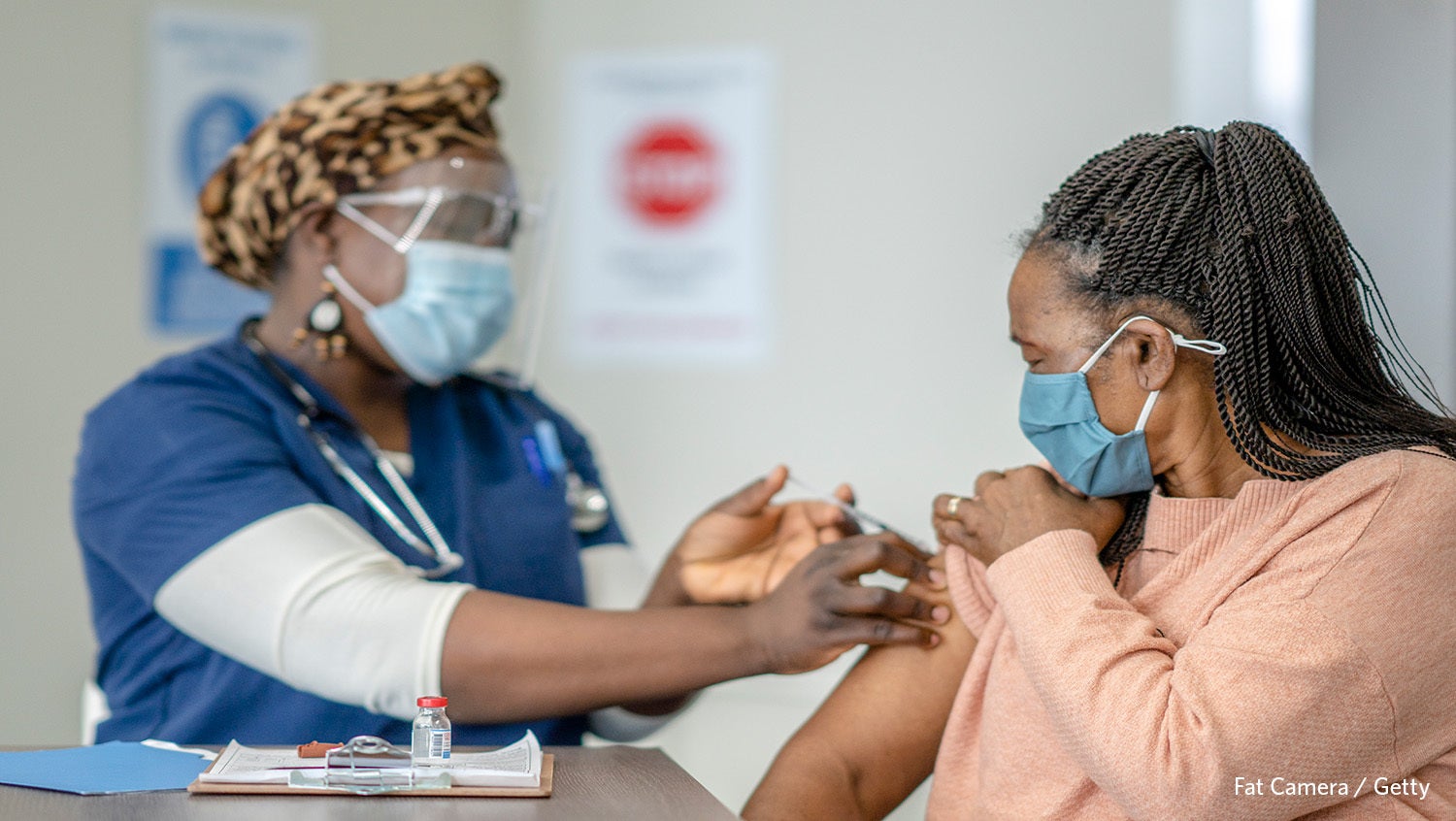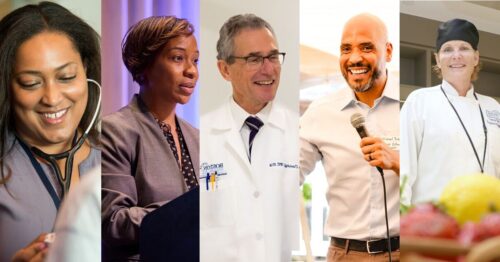What Role Can Medical Centers Play in the Equitable Rollout of COVID-19 Vaccines?
May 24, 2022

Getty Images
BMC model may serve as a blueprint for other medical centers committed to increasing access to vaccines through community-based interventions
Throughout the COVID-19 pandemic, communities of color have been disproportionally affected by the virus. In the United States, Black and Latino people have died from COVID-19 at nearly twice the rate of white people. In Boston, Black and Latino residents have been infected with COVID-19 at about 1.5 times the rate of their white neighbors. And yet, people of color have lower vaccination rates.
When the SARS-CoV-2 vaccine first became available, it was clear to leaders and clinicians at Boston Medical Center there was a need to target traditionally underserved populations. By utilizing a large number of community connections and collaborations already established and by bringing the vaccine directly out to these communities, BMC and its community partners were able to quickly develop a vaccine program that reached some of the area’s most vulnerable communities.
The results and accomplishments of BMC’s vaccine outreach were recently documented in the Annals of Internal Medicine, including the four most important lessons learned in the process:
- Reach people where they are
- Make a commitment to health equity and community engagement
- Adapt and pivot quickly
- Be patient in building vaccine confidence
Researchers hope other medical centers can use these learnings to develop a blueprint for their own vaccine outreach programs. To learn more about the vaccine program and these insights, HealthCity spoke with three of the paper’s authors, Sabrina Assoumou, MD, MPH; Petrina Martin Cherry, MBA; and Ellen Ginman, MPH.
Make vaccines more accessible in the community setting
Researchers found one of the most important ways to get the vaccine out was reaching people where they were rather than expecting them to come to the medical center. “We also understood the importance of providing vaccines in the communities that were the hardest hit,” says Assoumou. To do this effectively, BMC began by utilizing the deep relationships they have built over the years with community centers and community leaders and bringing them on board as partners. In some cases, these sites were already co-branded, such as the BMC Mattapan site.
“These health centers have been in their communities for decades and have ongoing relationships with their patients, who really trust them,” says Assoumou. “Many of these patients could not easily access the mass vaccination sites in the state, which were mostly located in the suburbs. So, we understood that putting these vaccination sites right in people’s neighborhoods was really key. And not only did we need to provide the vaccines, but we also needed to provide answers about the vaccine from trusted clinicians and leaders.”
BMC brought expertise and information to the communities by connecting panels of doctors with community-based leaders to answer questions from the community. These efforts were to be intentional in addressing some of the hesitancy around vaccines in many communities. “The goal was to have community-based leaders be our allies, advocates and ambassadors, in trying to get out information about these vaccines,” says Cherry.
At each site, community members heard from doctors and other clinicians who resembled them and spoke their language. “If we were addressing a Haitian community, we made sure we had the conversation in Haitian Creole with doctors and clinicians who are Haitian. We found that strategy was very effective for us,” says Cherry.
Assoumou says another key factor in meeting people where they were was leveraging the existing relationship between BMC and public health agencies like the Boston Public Health Commission and the Department of Public Health. “Because these relationships already existed, when it was time to make the vaccination available, we were able to be at the table for those discussions,” she says.
“State agencies shared our commitment to vaccine access in the hardest hit communities,” adds Ginman. “Early in 2021, there was more demand for vaccines than there were doses available. The state government supported our efforts to ensure equitable access by channeling scarce vaccine doses to our sites.”
Make a commitment to health equity
Another strategy that made BMC’s vaccine program unique was using the Social Vulnerability Index (SVI) to choose which communities to target. The SVI uses 15 measures of social vulnerability to identify communities that are most at risk for poor health outcomes, scoring them from 0 (lowest vulnerability) to 10 (highest vulnerability).
They used the SVI database to see where people were most affected by COVID-19. That data helped the team figure out where to put the various vaccination sites. “As a result, we put seven community-based vaccination sites in those areas,” says Cherry. “My role was to meet with community leaders and leaders of faith-based organizations to find locations in the community where patients and community members could conveniently access the vaccine within a mile or less from their homes.”
Cherry says these efforts showcase BMC’s commitment to being attuned to healthcare inequities, intentionally showing up in the community, and dismantling identified inequities. “It’s when we are investigating those inequities with a lens to improve and dismantle, and make sure we are showing up in a way that really serves the community, that we can make a change.”
Adapt to the highest need for the COVID-19 vaccine
As the weekly number of vaccinations started to decrease in June 2021, BMC shifted its efforts to engaging communities where the unvaccinated population was highest. At this point, their strategy pivoted from larger community sites to smaller, mobile vaccination events in faith-based organizations, schools, local community events, grocery stores, and apartment complexes.
“When we decided to do these mobile pop-up sites, we looked at data that could tell us block-by-block where people were who were not vaccinated,” says Cherry. Using this data, BMC hired teams of traveling nurses and set up about 400 pop-up sites around the city. They would set up a day to administer the first vaccine and come back another day to administer the second vaccine in the same location, offering the vaccine to everyone in the surrounding community.
“Boston Public Schools (BPS) has been an amazing partner with us, making sure we were able to provide vaccines directly at the schools. We had conversations with parents and PTA groups before the event to answer questions and to make sure they knew how to provide consent for their child to be vaccinated,” says Cherry. “Oftentimes, we’d see parents show up with grandparents and aunts and uncles, and we’d vaccinate the whole family.”
Before these events, BMC sent nurses door-to-door in the community to let neighbors know they would be at the school on a particular day. In some cases, they provided in-home vaccinations for those who could not make it to the event.
Be patient in building trust in the COVID-19 vaccine
Finally, the team found that having patience in building vaccine confidence ultimately paid off in many cases. “Given the historical context, many people may not trust the health care system,” says Assoumou. “So, you need to earn your patients’ trust. And we found that by being patient, building relationships, and providing information about the vaccine, we were able to build trust with patients. And over several encounters, people who were not interested at first did eventually get vaccinated.”
Assoumou says they hope the success of the vaccine program will inform other types of care the hospital provides. “As academic medical centers, we often think we know what needs to be done and we have the solutions. But what this study has taught us is that we need to develop an infrastructure and engage the community, so we can together come up with solutions that are actually going to work for that community.”
Study Results
- In addition to offering the SARS-CoV-2 vaccine on the medical campus, BMC established seven community-based vaccination clinics and conducted 99 individual mobile vaccination events.
- Community vaccination sites included a staff of between 20 and 100 annual FTEs depending on local needs.
- Mobile sites included a staff of approximately 12 annual FTEs, with community health workers, nurses, a supervisor, a director, and an event coordinator.
- As of November 28, 2021, BMC administered 109,938 first doses.
- Approximately 72% of vaccines administered at mobile events were given to people who approached and registered on the day of the event, with 89% being first doses.
- Community vaccination sites reached the largest number of people, with 94,703 (86%) first doses. Mobile sites vaccinated the fewest persons with 2,466 (2%) first doses but reached a more diverse and younger group of Boston residents.


